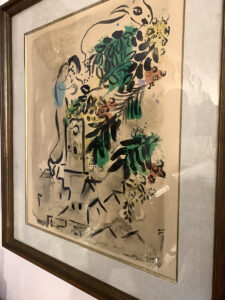 BL, a budding Gen Z art afficionado, asked if the fine art print market is a good investment. A great question. The answer is YES for some types of prints created in select eras in certain styles. For example, pop art is strong today. Let’s look at the world of prints, often called “multiples,” and see what sells NOW. Last month we saw top attendance and top dollars spent at three major print fairs.
BL, a budding Gen Z art afficionado, asked if the fine art print market is a good investment. A great question. The answer is YES for some types of prints created in select eras in certain styles. For example, pop art is strong today. Let’s look at the world of prints, often called “multiples,” and see what sells NOW. Last month we saw top attendance and top dollars spent at three major print fairs.
Printmaking comes in many forms, often a collaborative process between the artist and the printer. They call the same image printed in a sequence an edition—a numbered, limited series. Most connoisseurs consider a limited edition print an original work of art. Look for a fraction: 1/10 means the first strike in a series of ten, often handwritten in the margin. Look for an original signature, not just a signature as part of the image located “in the plate.” An “open” edition, on the other hand, isn’t a limited number of prints nor “numbered.” These are never as valuable as a numbered limited edition print, not usually signed by hand.
The artworld’s classic methods/mediums of printmaking:
- Etching, engraving, woodcut, dry point, aquatint and mezzotint are “intaglio” prints, meaning an image/drawing/composition is incised in a surface (in copper for example). Ink is applied directly to the incised surface, and the plate is pressed onto paper. The sunken deep lines “hold” the ink and with pressure create the image. An engraving/etching and a woodcut are typically an older style of printmaking associated with Old Master prints of late 18th century or earlier in the Western tradition. Think Albrecht Dürer, Rembrandt, and Francisco Goya.
- Lithograph: a drawing made on a stone using a special ink. The stone is then washed with acid, which penetrates the areas not drawn on. Rolling with printing ink, the ink “sticks” to the drawn parts, over which paper is pressed. David Hockney uses lithography extensively.
- Screenprint or Serigraph: a reproduction of an image via a stencil. For example, a photograph such as those portraits made by Warhol. The “screen” is a screened frame that bears the reversed image. Serigraph is a lesser valued version of this process, used by Peter Max.
Fine Art Print Market Growing Among Younger Buyers
Record attendance last month at NY’s International Fine Print Dealer’s Association Print Fair (21,000 visitors) occurred at the same time as the new Brooklyn and traditional Paris Fine Art Print Fairs. Auction houses saw younger buyers springing for affordable prints, especially in the Pop Art style, in online bidding. Twenty-to-forty-year-old buyers don’t only buy ultra-contemporary works but classic prints by Modern Masters (artists working 1920—1970s) such as Miro, Baldessari, and Hockney. My first print fair in the mid-1980s showed almost exclusively Old Master etchings and engravings. Now Old Master prints capture only twenty-five percent of the market.
One dealer at the New York Print Fair reported that a Gen Z buyer admired his great aunt’s classic Miro collection as a teen, vowing to buy his own Miro when he came of age. Modern Master prints are the bestsellers across the market (classics: Miro, Picasso, Hockey). Second bestsellers are contemporary prints, works of the last forty years. Lesser sellers are Old Master prints, except Rembrandts, which retain their strength in the market. The top selling artist in the print category? Andy Warhol, from 2015-24, with total sales of $501 million. After Warhol, top artists in this category are Picasso, Banksy and Jeff Koons, as well as the big bold iconic images by Lichtenstein and the colorfully accessible work of David Hockney.
My Buying Advice
BL, if money were no object, I recommend looking into Lichtenstein’s “Nude” series (1994) and Warhol’s “Endangered Species” Series (1983). Another name to purchase? George Condo. His surreal work will put you in mind of Salvador Dali and his cubist works in mind of Picasso. Condo is capitalizing on icons, as only a true Pop artist would.
Finally, BL, to purchase affordably, check out museum fundraisers. Notable museums often commission a printmaker to create an edition, sold to raise funds. These prints are typically works by important mid-career living artists, benefitting the museum and their reputation at the same time, and also, because of a limited “run” (a small edition of under, say 250) will increase in value.